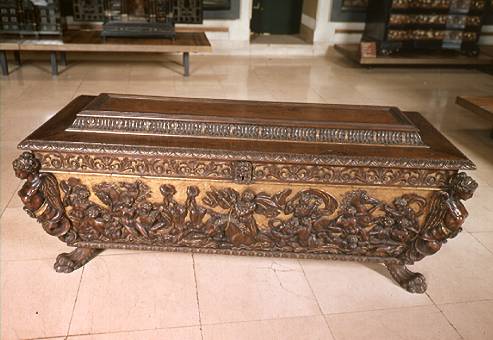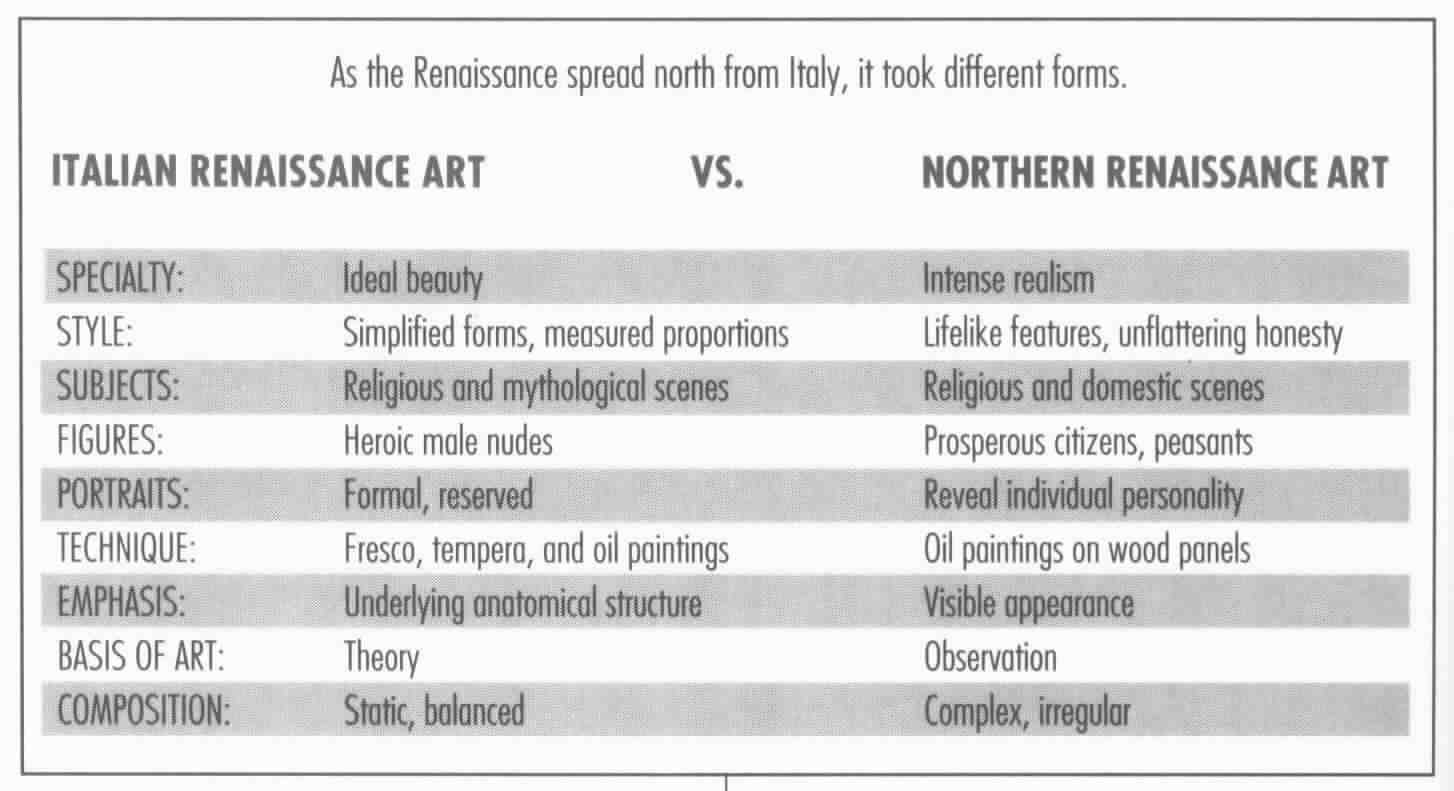4. High Renaissance Synopsis: art 162 honors
Renaissance and Baroque
Map
HIGH RENAISSANCE
The High Renaissance based in Rome and Venice was the culmination of an ascending movement in art that finally captured the essense of Greek and Roman classicism, even at times exceeding the Ancients' prowess. Idealism, naturalism, the adroit use of mathmematical theory in perspective and proportion, combined with classical qualities of order and harmony, created "classical" moments in painting, sculpture, and architecture. These were moments that "unified and balanced the conflicting experiences of an entire culture."
As Florence' influence waned due to changing political conditions in the late 15th century, the focal point of the Renaissance shifted to Rome and Venice. In Rome, the High Renaissance blossomed with the Church dispensing patronage in the sponsorship of grand works in art and architecture. The artistic achievements of Leonardo Da Vinci (1452-1519), Michaelangelo (1475-1564), Raphael (1483-1520) and Bramante (1444-1514) exemplified the Classical spirit that had imbued the works of the Greek High Classical era two thousand years previous to their time.
Concurrent with that of Rome, the High Renaissance as it appeared in Venice had a different emphasis than its Roman counterpart. While the High Renaissance centered in Rome concentrated on intellectual themes of virtues, heroics, epics and lofty concepts, Venice had a more sensual outlook with the creation of art that reflected the light and coloration of its seaside landscape.
The generation of artists following the High Renaissance were faced with the dillemma of either slavishly copying, or distinguishing themselves, from the masters' acknowledged perfection; the period known as "Mannerism" was this reaction to the glories of the High Renaissance.

The cassone was an Italian marriage chest popularized during the Renaissance.
This example is 16th-century Venetian and features relief carvings of
classical scenes. The winged figures on the corners are called caryatids,
and the feet of the chest are carved in a shape known as paw feet.
Source: Bridgeman Art Library, London/New York - Encarta
HIGH RENAISSANCE
• High Renaissance 1495 - 1520
• Renaissance in Venice 1500 - 1600
• Mannerism 1520 - 1580
TERMS:
Sfumato - smoky, hazy-like tonal blending in
a painting typical of da Vinci's "Madonna of the Rocks"
Spandrels
Pediment - a recessed and enframed triangular
space of a gable roof end, or as an architectural decorative element over
a window, niche, etc.
Sacra conversazione - the implied conversation
between holy and esteemed personages in a sculpture or painting
Central Plan - church or building plan with
symmetrical, equally-sized plan elements surrounding a central core
Figura serpentinata - a Mannerist
figural representation where the figure is contorted into a nearly-unnatural
"s"-shape.
Cornice - outermost trimwork on eaves of a gabled
roof structure and its pediment
Mannerism - stylistic
reaction to the perceived "perfection" of the High Renaissance,
with distorted emotional figures, acidic colorations, swirls of action
around the perimeters; sophisticated elegance.
SLIDE LIST
Leonardo da Vinci, 1452- 1519
Madonna of the Rocks, c. 1485
Madonna and Saint Anne, 1501-1513
Last Supper, 1495 - 98
Mona Lisa, 1503 - 1505
Danato Bramante, (1444- 1514)
Tempietto, San Pietro in Montorio,
Plan for St. Peter’s, Rome 1505
1475 - 1564
1498 - 1500
Rome 1502-11
Michelangelo Buonarroti, 1475-1564
The Vatican Pieta,
David, 1501 - 1504
Moses, 1513 - 1515 & Dying Slave & Bond (Rebellious) Slave 1513
- 16
Ceiling Frescoes, Sistine Chapel, Vatican, 1508 - 12
Creation of the Sun, Creation of Adam
The Fall of Man and Expulsion from Paradise, The Deluge
Tomb of Giulian de’ Medici & Lorenzo de’ Medidci Medici
Chapel
Last Judgement, Sistine Chapel, 1534 - 1541
St. Peter’s, 1546- 1564
1519- 1534
Raphael (Raffaello Sanzio), 1483 - 1520
Madonna with the Goldfinch, 1505 - 06
School of Athens (Philosbpphy), 1509 - 11
Galatea, 1513
The Sistine Madonna, 1513 - 15
Renaissance in Venice 1500 - 1600
Giovanni Bellini, 1430- 1516
San ZaccariaAltarpiece, Oil on wood, 16’S” x 1505
The Feast of the Gods, Oil on canvas, 5’ 7” x 6’ 2”,
1529
Giorgione da Castelfranco, c. 1477- 1510
The Tempest, Oil on canvas, 2’7” x 2’ 43/4”, c.
1510
Titian (Tiziano Vecelli), 1490- 1576
Sacred and Profane Love, Oil on canvas, 3’ 11” x 9’2”,
c. 1515
Bacchanal of the Andrians, c. 1520
Madonna of the Pesaro Family, Oil on canvas, 16’ x 9’, 1519
- 26
Venus of Urbino, Oil on canvas, 48” x 66”, 1538
Correggio, Antonio Allegri daCorreggio, c.1489 - 1534
Assumption of the Virgin, Dome of Parma Cathedral, 1526 - 1530
Jupiter and Jo, Oil on canvas, 64 1/2 “ x 29 3/4”, 1532
Tintoretto (Jocopo Robusti), 1518 - 94
Last Supper, Oil on canvas, 12’ x 18’S” 1594
Andrea Palladio, 1508 - 80
Villa Rotonda, 1566- 1570
Giorgio Maggiore, Venice, 1565
Mannerism 1520 - 1580
Jacopo da Pontormo, 1494- 1557
Descent from the Cross, Oil on wood, 10’ 3” x 6’ 6”,
1525- 1528
Parmigianino, Girolamo Francesco Maria Mazzola, 1503 - 1540
Madonna with the Long Neck, Oil on wood, 7” x 4’ 4”,
1535
Bronzino, Agnolo di Cosimo 1503 - 1572
Venus, Cupid, Folly & Time (Exposure of Luxury) Oil on wood 61”
x 56”, 1546
Portrait of a Young Man, Oil on wood, 3’ 1” x 2’ 5”,
c. 1530’s
Sofonisba Anguissola (1527 - 1625)
Portrait of the Artist’s Sisters and Brother, c. 1555
Giovanni da Bologna, 1529- 1608
Abduction of the Sabine Women, Marble, 13’ 6”, 1583
Links:
NM's Creative Impulse: The Development of Western Civilization
- World History - Renaissance
(Links Page)
http://history.evansville.net/renaissa.html
Cosimo I dé Medici Duke and later Grand Duke of Tuscany
http://www.mega.it/eng/egui/pers/cospri.htm
Univ. of St. Andrews School of Art History
Art works comparison modules
Leonardo da Vinci's evolution of theme of the Virgin and Child and St.
Anne
http://www-ah.st-andrews.ac.uk/under/ah1001_slides.html#7A
Univ. of St. Andrews School of Art History
Art works comparison modules
Bellini's Sacra Conversazione altarpieces & their sources:
http://www-ah.st-andrews.ac.uk/under/ah1001_slides.html#6A
Old Masters at Sotheby's
http://www.thecityreview.com/w01soldm.html
University of Virginia:
Renaissance and Baroque Architecture: Architectural History 102
http://www.lib.virginia.edu/dic/colls/arh102/index.html
Notes:

Source: (A-40)
Maniera - name given the style by Mannerist
theorists; almost exclusively an art of the human figure...the Mannerist
requirement of invention leads its practioner to the maniera, a self-conscious
stylization involvng complexity, caprice, bizarre fantasy (the "conceit.")...Elegance,
precosity, and polish. (G-9, 668)